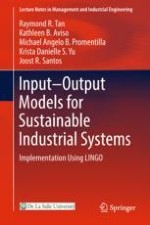
2019 | OriginalPaper | Buchkapitel
1. Introduction to Input–Output Models
verfasst von : Raymond R. Tan, Kathleen B. Aviso, Michael Angelo B. Promentilla, Krista Danielle S. Yu, Joost R. Santos
Erschienen in: Input-Output Models for Sustainable Industrial Systems
Verlag: Springer Singapore
Aktivieren Sie unsere intelligente Suche, um passende Fachinhalte oder Patente zu finden.
Wählen Sie Textabschnitte aus um mit Künstlicher Intelligenz passenden Patente zu finden. powered by
Markieren Sie Textabschnitte, um KI-gestützt weitere passende Inhalte zu finden. powered by